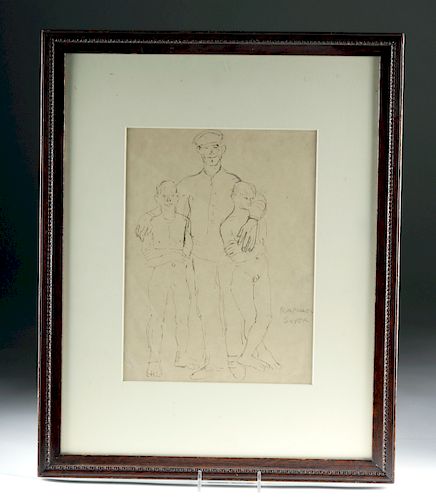Signed 1920s Raphael Soyer Ink Drawing, ex Bonhams
Lot 122
About Seller
Artemis Gallery
686 S Taylor Ave, Ste 106
Louisville, CO 80027
United States
Selling antiquities, ancient and ethnographic art online since 1993, Artemis Gallery specializes in Classical Antiquities (Egyptian, Greek, Roman, Near Eastern), Asian, Pre-Columbian, African / Tribal / Oceanographic art. Our extensive inventory includes pottery, stone, metal, wood, glass and textil...Read more
Estimate:
$500 - $700
Absentee vs Live bid
Two ways to bid:
- Leave a max absentee bid and the platform will bid on your behalf up to your maximum bid during the live auction.
- Bid live during the auction and your bids will be submitted real-time to the auctioneer.
Bid Increments
| Price | Bid Increment |
|---|---|
| $0 | $25 |
| $300 | $50 |
| $1,000 | $100 |
| $2,000 | $250 |
| $5,000 | $500 |
| $10,000 | $1,000 |
| $20,000 | $2,500 |
| $50,000 | $5,000 |
| $100,000 | $10,000 |
| $200,000 | $20,000 |
About Auction
By Artemis Gallery
Jun 6, 2019
Set Reminder
2019-06-06 10:00:00
2019-06-06 10:00:00
America/New_York
Bidsquare
Bidsquare : VARIETY AUCTION | Ancient & Ethnographic
https://www.bidsquare.com/auctions/artemis-gallery/variety-auction-ancient-ethnographic-4182
Around the world & back in time - be amazed at the treasures you will find. Antiquities from Egypt, Greece, Italy and the Near East, Asian, Pre-Columbian, African / Tribal / Oceanic, Native American, Spanish Colonial, Russian Icons, Fine Art, much more! All categories, all price ranges...all legal Artemis Gallery info@artemisgallery.com
Around the world & back in time - be amazed at the treasures you will find. Antiquities from Egypt, Greece, Italy and the Near East, Asian, Pre-Columbian, African / Tribal / Oceanic, Native American, Spanish Colonial, Russian Icons, Fine Art, much more! All categories, all price ranges...all legal Artemis Gallery info@artemisgallery.com
- Lot Description
Raphael Soyer (American, 1899-1987), "Father and Sons" ink on paper, ca. 1920s to 1930s. Signed on lower right. A framed and signed ink drawing of a father with his arms around his sons - both nude and perhaps about to take a bath or go skinny dipping - by Social-Realist artist Raphael Soyer. During the Great Depression, his artwork captured the human condition with a social protest bent popular at the time. Portraits of laborers and unemployed workers were some of his favorite subjects; however, he also depicted his friends, family, and studio models. Soyer once aptly stated, "From all that I have seen, I am more than ever convinced that art must communicate, and it must represent, describe and express people, their lives and times." Size: 19.625" L x 15.75" W (49.8 cm x 40 cm) including frame
Born in Borisoglebsk, Russia, Raphael Soyer and his family immigrated to the Bronx, New York City in 1912 due to political turmoil in Czarist Russia. Living in New York had its advantages for a budding artist. Soyer studied art at Cooper Union, where he met and befriended the artist Chaim Gross. Following this, he studied under the artist Guy Pène du Bois at the Art Students League, and became linked with Reginald Marsh and Peggy Bacon. During his life he showed at many reputable institutions such as the Whitney Museum of American Art in New York, the Carnegie Museum of Art in Pittsburgh, and the Corcoran Gallery of Art in Washington, D.C. Today, his works are included in the collections of the Art Institute of Chicago, The Museum of Modern Art in New York, and the Museum of Fine Arts in Boston.
Provenance: private San Francisco, California, USA collection; acquired at Bonhams & Butterfields, 15 August 2010, lot 5099
All items legal to buy/sell under U.S. Statute covering cultural patrimony Code 2600, CHAPTER 14, and are guaranteed to be as described or your money back.
A Certificate of Authenticity will accompany all winning bids.
We ship worldwide and handle all shipping in-house for your convenience.
#143648Framed under glass. This drawing has not been examined outside of the frame, but appears in good condition save some creases in the paper.Condition
- Shipping Info
-
All shipping is handled in-house for your convenience. Your invoice from Artemis Gallery will include shipping calculation instructions. If in doubt, please inquire BEFORE bidding for estimated shipping costs for individual items.
-
- Buyer's Premium



 EUR
EUR CAD
CAD AUD
AUD GBP
GBP MXN
MXN HKD
HKD CNY
CNY MYR
MYR SEK
SEK SGD
SGD CHF
CHF THB
THB

















